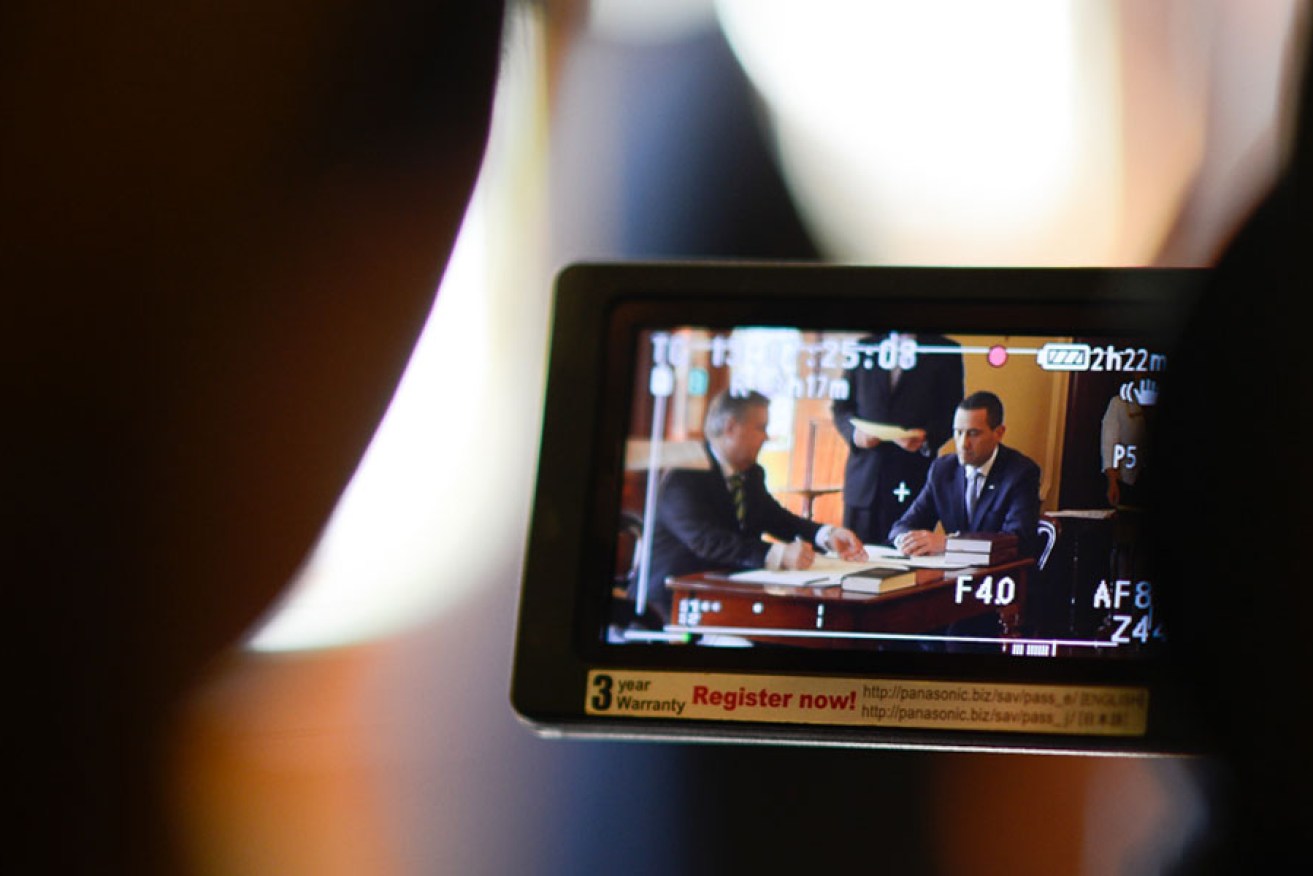Sustainable budget critics wrong on every point

A TV camera captures Tom Koutsantonis being sworn in as Treasurer last month. Photo: Nat Rogers/InDaily
Treasurer Tom Koutsantonis’s State Budget faces even bigger economic hurdles than those facing Kevin Foley in 2010 when a raft of cuts were proposed – and resisted.
Economic assumptions that were the basis for a union campaign against Foley’s proposed public service cuts in 2010 have turned out to be wrong in almost every respect.
Foley had commissioned a report into expenditure across the public sector and how much of it could be sustained in a responsible Budget.
The resulting recommendations of the Sustainable Budget Commission drew a rapid response from the Public Service Association.
In August 2010 the union launched a community campaign aimed at fighting the State Government’s plans to slash $750 million from jobs and services in the 2010-11 Budget.
History shows their campaign was successful – Foley was given the chop and the public service is larger than ever.
The 2010 union campaign used an economic research report which it had itself commissioned to argue that the cuts were not only unnecessary, but also contrary to South Australia’s positive economic and fiscal outlook.
The research – by Associate Professor John Spoehr from the University of Adelaide’s Australian Institute for Social Research – concluded there had been “significant upward revisions in economic, employment and revenue growth that were not anticipated in framing the 09/10 State Budget”.
“The Government can no longer hide behind a story that doesn’t add up – the simple fact is these cuts are not needed,” said PSA General Secretary Jan McMahon at the time.
This report’s upbeat view of the economic upswing, however, would turn out to be a false dawn.
It also found there was “no realistic prospect of a credit downgrade” and the economic and budget outlook for South Australia “provides a foundation for growth rather than contraction”.
It wasn’t too long before South Australia suffered not one, but two credit rating downgrades.
It’s worthwhile revisiting the economic assumptions that were used to successfully argue for the cuts to be resisted.
1. “The State Government’s most recent estimates (January 2010) show that the net operating balance position for the State Budget is expected to have improved by $110 million in total over the period 2009-10 to 2012-13.”
It didn’t turn out that way.
The January 2010 estimate for the Budget net operating balance in 2012-13 was for a surplus of $316 million; the actual result for that year was a net deficit of -$948 million.
That’s a massive difference of $1.26 billion.
2. “The most recent Commonwealth Government projections (July 2010) for GST payments and general revenue assistance to South Australia have been revised upwards by $898.5 million over the period to 2012-13 compared with the estimates published in its 2009-10 Mid-Year Economic and Fiscal Outlook produced in late 2009.”
Wrong again. Commonwealth projections were revised downward in successive years and, despite additional funds for projects such as South Road, total GST and general assistance fell around $300 million short of that expected back in January 2010, let alone the later revision upwards.
3. “South Australia is receiving around $1.77 billion in economic stimulus funding from the Australian government which has enabled a much higher level of capital expenditure to be achieved in the State than has been possible in the recent past.”
The funding came – and then dried up as pressure mounted on the Federal Budget.
4. “The combination of the Mid-Year Budget Review net revenue improvement, the increase in GST and general assistance revenue, and the economic stimulus contribution to South Australia leads to an estimate of $2.8 billion extra net revenue for (or extra payments to) South Australia to 2012-13.”
The extra net revenue didn’t happen.
5. “The risk of a credit downgrade has been significantly reduced by the improved economic and financial outlook. There is no realistic prospect of a credit downgrade given current economic and budgetary conditions.”
Bang. The hammer came down on May 31, 2012, when Standard & Poors cut the State’s Triple A credit rating, citing declining revenues and new spending.
“The budget includes new spending initiatives that will only be partially offset by new savings measure,” Standard & Poor’s credit analyst Claire Curtin said.
The agency said it was no longer expecting a “structural improvement in South Australia’s finances”.
There were further downgrades in 2013 and the latest assessments suggest South Australia is years away from returning to a Triple A rating.
The union campaign had scoffed at predictions by the Sustainable Budget Commission.
“The Sustainable Budget Commission argues that ‘a lower credit rating for South Australia would directly increase Government borrowing costs, borne by taxpayers. Other indirect costs of a ratings downgrade potentially would be more important. A triple-A credit rating tells investors the Government is managing the State’s finances and economy in a responsible manner. It’s an indicator of a stable investment environment’,” the union campaign material said.
The unions, however, had a better view: “The risk of a credit downgrade has been significantly reduced by the improved economic and financial outlook.There is no realistic prospect of a credit downgrade given current economic and budgetary conditions.”
They couldn’t have been any further off the mark.
As new Treasurer Tom Koutsantonis prepares to deliver his first State Budget on June 19, will he bend to the view that the public service should be preserved from cuts or will he do what should have been done four years ago?




